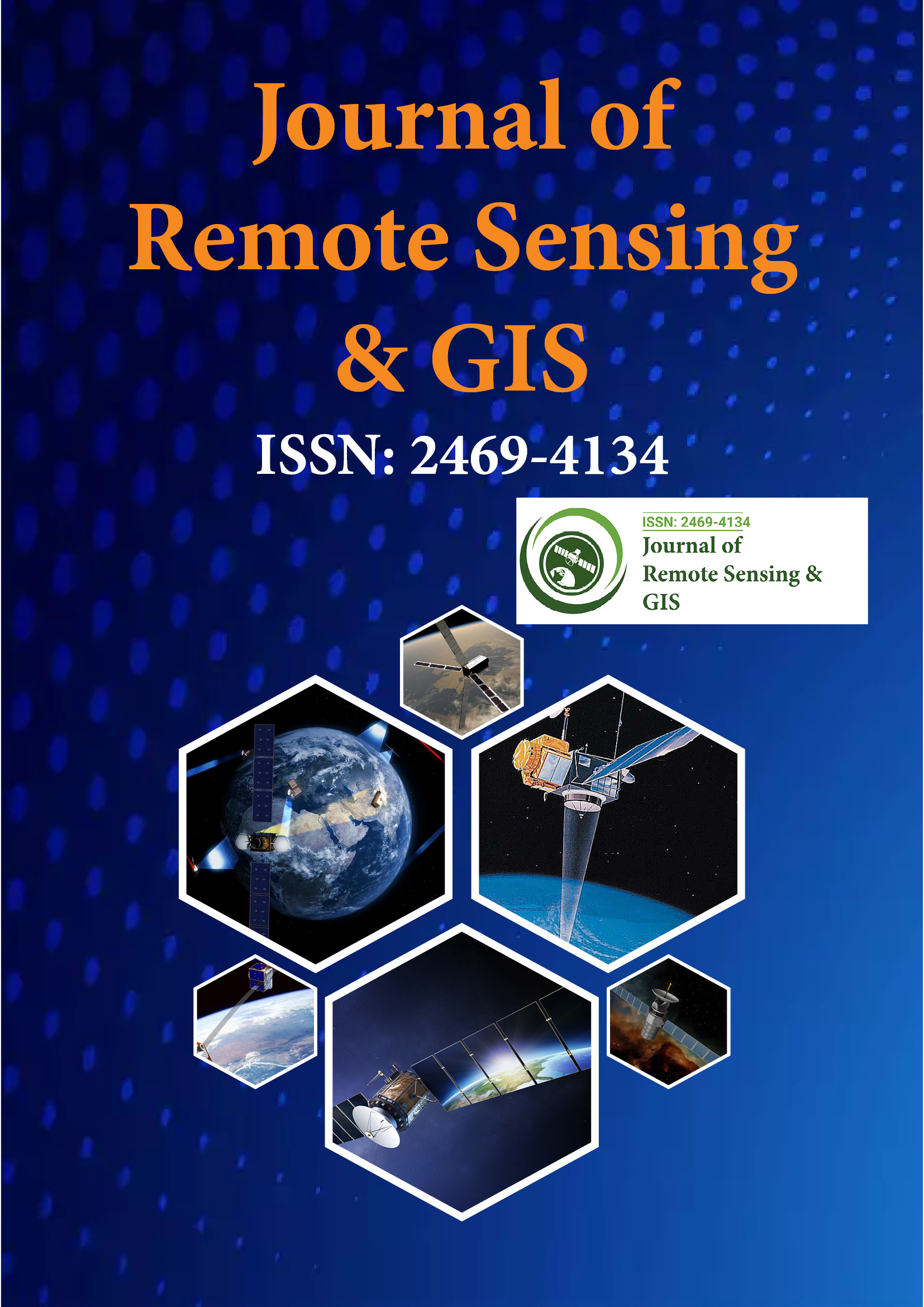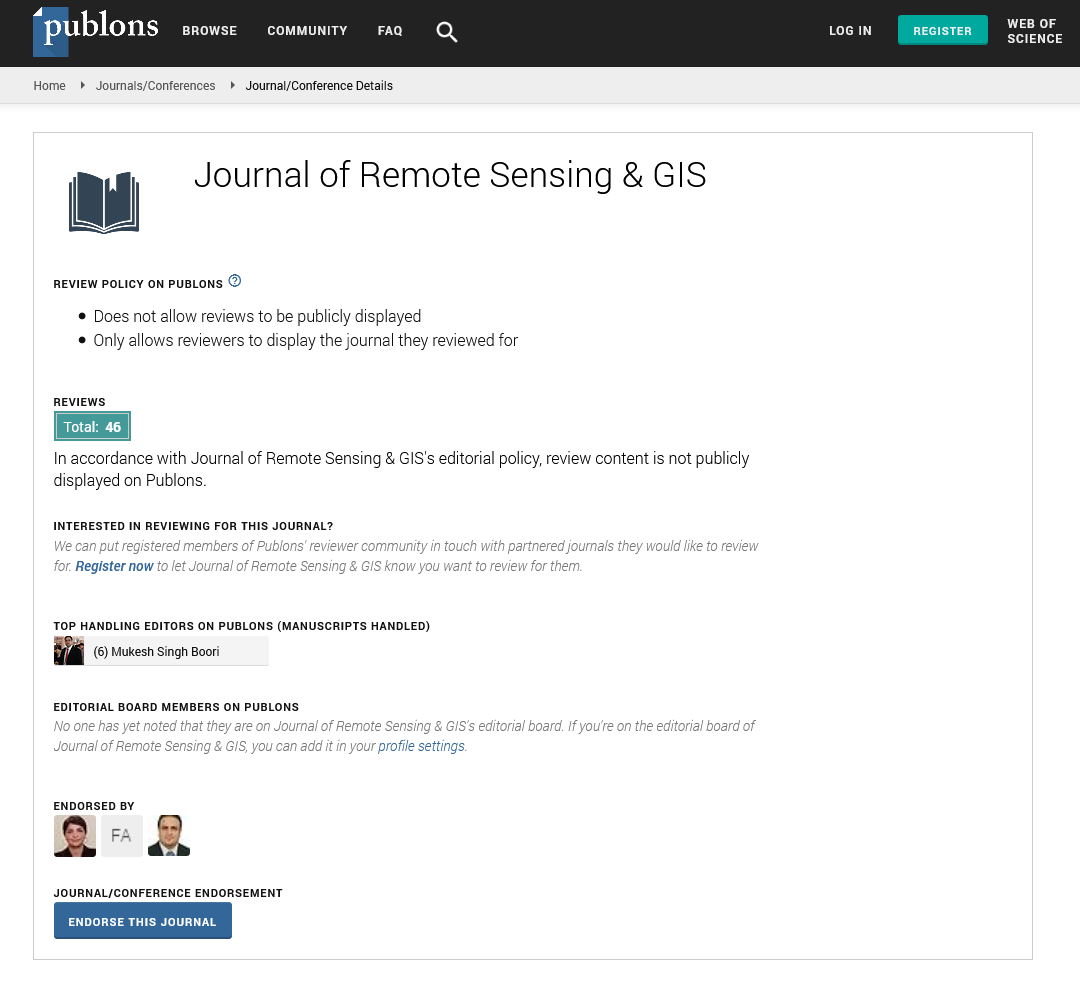Indexed In
- Open J Gate
- RefSeek
- Hamdard University
- EBSCO A-Z
- OCLC- WorldCat
- Publons
- International Scientific Indexing
- Euro Pub
- Google Scholar
Useful Links
Share This Page
Journal Flyer

Open Access Journals
- Agri and Aquaculture
- Biochemistry
- Bioinformatics & Systems Biology
- Business & Management
- Chemistry
- Clinical Sciences
- Engineering
- Food & Nutrition
- General Science
- Genetics & Molecular Biology
- Immunology & Microbiology
- Medical Sciences
- Neuroscience & Psychology
- Nursing & Health Care
- Pharmaceutical Sciences
Opinion Article - (2024) Volume 13, Issue 2
Enhancing Environmental Monitoring through Semantic Segmentation of Satellite Data
Chong Zhou*Received: 03-Jun-2024, Manuscript No. JGRS-24-26272; Editor assigned: 06-Jun-2024, Pre QC No. JGRS-24-26272 (PQ); Reviewed: 20-Jun-2024, QC No. JGRS-24-26272; Revised: 27-Jun-2024, Manuscript No. JGRS-24-26272 (R); Published: 04-Jul-2024, DOI: 10.35248/2469-4134.24.13.346
Description
Understanding and managing the Earth's ecosystems, natural resources, and the effects of human activity depend heavily on environmental monitoring. With the advent of satellite technology, we now have unprecedented access to high- resolution imagery covering vast and remote areas. However, transforming this data into actionable insights requires advanced analytical techniques. One such technique is semantic segmentation, a type of image analysis that can significantly enhance environmental monitoring. Semantic segmentation is a process in computer vision that involves classifying each pixel in an image into a predefined category. Unlike simple classification, which assigns a single label to an entire image, semantic segmentation provides a detailed understanding by distinguishing different objects and regions within the image. This technique is particularly useful for analyzing satellite data, where various land cover types and environmental features must be identified and monitored.
Applications of semantic segmentation in environmental monitoring
Land cover classification: Semantic segmentation can accurately classify different land cover types such as forests, urban areas, water bodies, agricultural fields, and bare soil. This detailed classification is essential for tracking changes in land use, deforestation rates, urban expansion, and habitat loss.
Vegetation health monitoring: By segmenting satellite images into different vegetation types and health categories, researchers can assess the condition of crops, forests, and grasslands. This information is crucial for agricultural management, forestry, and conservation efforts.
Water resource management: Semantic segmentation helps in identifying and monitoring water bodies, including rivers, lakes, and wetlands. This enables better management of water resources, detection of illegal water use, and monitoring of changes due to climate change or human activities.
Urban planning and development: Accurate segmentation of urban areas supports urban planning and infrastructure development. It helps in monitoring urban sprawl, zoning, and land use planning, ensuring sustainable and organized growth.
Disaster management: During natural disasters such as floods, wildfires, and landslides, semantic segmentation provides detailed maps of affected areas. This information is vital for emergency response, damage assessment, and recovery planning.
Coastal and marine monitoring: Coastal areas are highly dynamic and vulnerable to environmental changes. Semantic segmentation can map shorelines, monitor erosion, and track changes in coastal ecosystems, aiding in coastal zone management and protection.
Benefits of semantic segmentation in environmental monitoring
High precision and accuracy: Semantic segmentation provides pixel-level classification, offering a high degree of precision and accuracy. This level of detail is essential for reliable environmental monitoring and decision-making.
Automation and scalability: The automation of image analysis through semantic segmentation allows for the processing of large volumes of satellite data. This scalability is important for monitoring vast and remote areas that are otherwise difficult to survey.
Timeliness: With the continuous stream of satellite data, semantic segmentation enables near real-time monitoring. This timeliness is critical for responding to environmental changes and natural disasters promptly.
Cost-effectiveness: Automating the analysis of satellite imagery reduces the need for extensive ground surveys, making environmental monitoring more cost-effective. This allows for more frequent and comprehensive monitoring efforts.
Enhanced insight and decision-making: Detailed and accurate maps generated through semantic segmentation provide valuable insights into environmental conditions and trends. These insights support informed decision-making for conservation, resource management, and policy development.
Challenges of semantic segmentation in environmental monitoring
Data quality and availability: The accuracy of semantic segmentation depends on the quality and resolution of satellite data. Cloud cover, sensor noise, and limited temporal resolution can affect data quality and hinder analysis.
Algorithm complexity and training: Developing and training semantic segmentation algorithms require significant computational resources and expertise. Ensuring that these algorithms are robust and generalizable across different environments is a complex task.
Labeling and ground truth data: Creating labeled datasets for training segmentation algorithms is time-consuming and labor-intensive. Ground truth data, which serves for algorithm performance, is often limited or unavailable for remote areas.
Interpretability and validation: Ensuring that the results of semantic segmentation are interpretable and accurate is important. Validation of segmentation results against ground truth data is necessary to build trust and confidence in the analysis.
Semantic segmentation of satellite data represents a significant advancement in environmental monitoring. By providing detailed, accurate, and timely information, this technology enhances our ability to understand and manage the Earth's natural resources and ecosystems. Despite challenges related to data quality, algorithm complexity, and validation, the future prospects of semantic segmentation are promising. Continued advancements in machine learning, integration with other technologies, and the engagement of citizen scientists will further enhance the capabilities and applications of this powerful tool. The use of semantic segmentation, it will play a vital role in addressing environmental challenges and promoting sustainable development.
Citation: Zhou C (2024) Enhancing Environmental Monitoring through Semantic Segmentation of Satellite Data. J Remote Sens GIS. 13.346.
Copyright: © 2024 Zhou C. This is an open-access article distributed under the terms of the Creative Commons Attribution License, which permits unrestricted use, distribution, and reproduction in any medium, provided the original author and source are credited.

